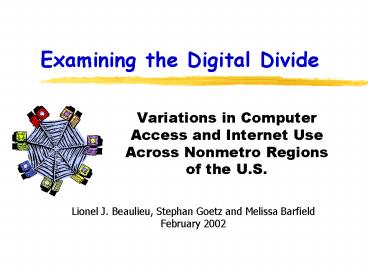Examining the Digital Divide - PowerPoint PPT Presentation
1 / 35
Title:
Examining the Digital Divide
Description:
The advent of the Internet has opened up the windows of opportunity to people ... report, 'Falling Through the Net: Toward Digital Inclusion'paints an upbeat ... – PowerPoint PPT presentation
Number of Views:42
Avg rating:3.0/5.0
Title: Examining the Digital Divide
1
Examining the Digital Divide
- Variations in Computer Access and Internet Use
Across Nonmetro Regions of the U.S.
Lionel J. Beaulieu, Stephan Goetz and Melissa
Barfield February 2002
2
Introduction
- The advent of the Internet has opened up the
windows of opportunity to people and communities
across America. - This technology has reduced the cost of social
space, allowing individuals living in more remote
areas of the U.S. to gain access to information
accessible to those living in the more populated
areas of the country. - Major strides have been made in promoting digital
inclusion among all of our nations residents. - The Department of Commerces report, Falling
Through the Net Toward Digital Inclusionpaints
an upbeat picture of the significant advances
that have been made in the adoption and use of
the Internet by Americans.
3
However . . .
- Ready access to both computers and to the
Internet remains more a dream than a reality to
countless individuals in the U.S - This includes the elderly, African Americans,
Hispanics, poorly-educated, those of low-income,
and persons living in rural areas of the country. - Such disparities has been the basis for the
rallying cry regarding the presence of a digital
divide in this nation.
4
Purpose
- Recent studies suggest that the gap in computer
ownership and Internet use is closing between
metro and nonmetro residents - But, these studies are simplistic in that they
fail to consider the unique series of demographic
and socioeconomic forces at play across the
distinct regions of the United States. - The purpose of this paper is to examine adoption
of CITs among metro and nonmetro people living in
the four distinct geographic regions of the
country.
5
Why Important?
- Increasingly, digital inclusion is becoming a
prerequisite for full participation in the
economic, political, and social life of America. - It is estimated that 60 percent of current jobs
now require some skills in the use of technology. - Without such capability, it will be difficult for
individuals to fully participate in the more
complex, technology-oriented dimensions of our
nations economy.
6
Methodology
- Data are from the fourth survey of the Department
of Commerces Falling Through the Net Series - Information on computer access and Internet use
was gathered from the 2000 CPS survey conducted
in August of that year - Approximately 48,000 households were part of the
study
7
Key Factors Influencing Home Computer Access
Internet Use at Home or Work
8
The Importance of Spatial Location
- Latest reports appear to indicate that rural
areas are catching up with larger areas in terms
of computer access and Internet use - Little has been done, however, to explore how
access and use across metro and nonmetro areas
might vary across the four regions of the U.S.
9
Computer Access in the Home in the United States
- Profile by Metro Status and Key Characteristics
10
Computer Access in U.S. Homes, by Metro Status
11
Computer Access in U.S. Homes, by Gender,
Race/Ethnicity and Metro Status
12
Computer Access in U.S. Homes, by Age and Metro
Status
13
Computer Access in U.S.Homes, by Education and
Metro Status
14
Computer Access in U.S. Homes, by Family Income
and Metro Status
15
Computer Access in the Home in the United States
- Profile by Metro Status and U.S. Regions
16
Computer Access in Metro and Nonmetro Homes,by
U.S. Regions
17
Computer Access in Nonmetro Homes, by Gender and
Region
18
Computer Access in Nonmetro Homes, by
Race/Ethnicity and Region
19
Computer Access in Nonmetro Homes, by Presence of
Children Under 18 Years Old and Region
20
Computer Access in Nonmetro Homes, by Education
and Region
21
Computer Access by Nonmetro Homes, by Family
Income and Region
22
Internet Use at Home or Work in the United States
- Profile by Metro Status and Key Characteristics
23
Internet Use at Home or Work in the U.S., by
Metro Status
24
Internet Use at Home/Work in the U.S., by Gender,
Race and Metro Status
25
Internet Use at Home/Work in the U.S., by Age and
Metro Status
26
Internet Use at Home/Work in the U.S., by
Education and Metro Status
27
Internet Use at Home/Work in the U.S., by Family
Income and Metro Status
28
Internet Use at Home or Work in the United States
- Profile by Metro Status and U.S. Regions
29
Internet Users in Metro and Nonmetro Areas, by
U.S. Regions
30
Internet Use at Home/Work in Nonmetro Areas, by
Gender and Region
31
Internet Use at Home/Work in Nonmetro Areas, by
Race/Ethnicity and Region
32
Internet Use in Home/Work in Nometro Areas, by
Presence of Children Under 18 Years Old and Region
33
Internet Use at Home/Work in Nonmetro Areas, by
Education and Region
34
Internet Use at Home/Work in Nonmetro Areas, by
Family Income and Region
35
Conclusions
- Investments in digital inclusion must be
undertaken in a more systematic, targeted fashion - Rural South lags behind the rest of the nation on
computer access and Internet use - Focus must be given to those facing the greatest
obstacles to adoption -- persons with a high
school education or less, Hispanics, African
Americans, elderly - Must address the last mile problem in the rural
South - Youth should be seen as important resources for
facilitating the diffusion of CIT to older rural
residents































